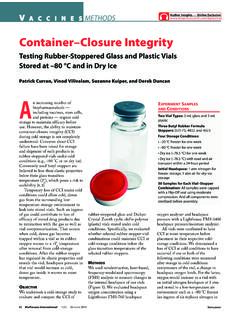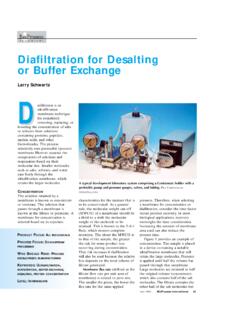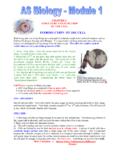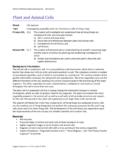Transcription of Supplementation of Animal Cell Culture Media
1 28 BioProcess International JUNE 2005 SUPPLEMENTS ince Harry Eagle s development of synthetic Animal cell Culture medium in 1955, culturists have found the need to supplement, or add ingredients to, standard Media formulations. Supplementation can occur at the time of Media preparation from powder, as when adding sodium bicarbonate, or ingredients can be added to sterile liquid Media , such as when adding Animal serum to commercial liquid formulations. It can be a simple step, as in the addition of a sterile antibiotic solution at the time of Culture , or a sophisticated process, as in model-determined multistep fed-batch Culture . Determining what Supplementation may be used in a particular application involves such things as examining the nature of the base (or basal) medium, the cell line used, and the application at hand, as well as considering what components may be tolerated by both the immediate Culture and subsequent downstream processes.
2 Specific factors considered in Culture Supplementation include the time and amount of addition; the supplement s physical state (solution, emulsion, or powder) and components (from metal salts to high molecular-weight protein); stability of components (both physical and chemical); stability and processability of the final (postsupplementation) medium; and the degree of process optimization required. Interestingly, most materials added as supplements, including such common ones as serum, can be included as part of standard formulations. There are a number of distinct reasons for their omission and subsequent specification as supplements: allowing end-users to specify their unique initial concentrations of each separate supplement; to change the concentration throughout an application; to produce unique combinations of such materials; and to select specific vendors for each separate MEDIUMM ajor advances in Culture Media include serum-reduced and serum-free Media (SFM).
3 SFM have in turn evolved into protein-free (PF), Animal -derived component free (ADCF), and chemically defined (CD) formulations. Early, or classical, Media were designed to be supplemented with serum and to support a wide spectrum of cells and applications. Those Media balanced amino acid and carbohydrate levels to Culture densities achievable with serum Supplementation combined with known types and levels of such cofactors as vitamins and trace metals. Common classical Media include such familiar names as MEM and RPMI 1640 (see Chapter Two). They rely upon serum to supply much of their nonnutritive Culture -promoting potential. However, the standard medium for many users has become SFM, and each such formulation is often more specialized in its cell line and application potential than are the classical Media .
4 This trend is occurring at a time when more and more cell lines and unique Culture applications are being developed. From the isolation of rare and specialized cells (such as mesenchymal stem cells ) to ex vivo Culture cell-based therapies ( , T cells ) to the 20,000-L scale production of recombinant products (mainly monoclonal antibodies and other proteins), highly specialized applications demand more function and efficiency from the Media used. Such developments have increased the frequency and diversity of Culture Media Supplementation . SUPPLEMENTSH undreds of individual compounds can be added to cell Culture Media , TINA RENCELJ ( ) Supplementation of Animal Cell Culture Mediaby William G. WhitfordC H A P T E R THREESUPPLEMENT especially in the interest of researching their specific effects.
5 But the concept of Media Supplementation is usually limited to addition of materials that generally promote establishment and maintenance of a cell Culture . These Media supplements come in a wide range of molecular types and physical states. They vary in complexity (from a defined amino acid to partially hydrolyzed Animal tissue), in chemical nature (from gentamicin to glutamine), and in molecular weight (from calcium chloride to methylcellulose). Furthermore, particular supplements can be obtained in a number of packaged states, such as frozen liquid or lyophilized powders. Along with the diverse number of Media and applications in which any one can be used, the many variations prohibit specific formulation, filtration, dosage, and storage information from being supplied here.
6 However, some general principles can be mentioned. Factors to research in the application of any supplement include cell- Culture use validation of the source material; methods of intermediate processing such as rehydration, sterilization, aliquoting, storage, and testing; timing, means, and amount of Supplementation ; and ancillary effects of the supplement on other aspects of the Culture or downstream processing. Supplement contraindications occur in the areas of regulatory compatibility ( , adding protein to a protein-free medium), process compatibility ( , some supplements cannot be filtered once diluted in SFM), and component compatibility ( , some combinations of antibiotics can be toxic in SFMs). Because even ultra-pure reagents can demonstrate toxicity or lack of performance in some cell cultures, it is important to select only those validated for a given application.
7 For practical reasons, liquid supplements other than serum must be concentrates in the range of 50 5000 the desired final concentration (1). Animal blood serum is by far the most common supplement to Culture medium. It provides necessary proteins, growth factors, hormones, lipids, vitamins, attachment factors, and trace metals for culturing cells in leaner classical Media formulations. Because serum has been used in cell Culture for so long (actually over a century), numerous dogma about material selection and use have arisen, and the value of such reports varies greatly. Examples include basic questions regarding acceptable storage conditions (such as frozen or refrigerated), filterability after dilution, and heat treatments.
8 Objective and systematic assessments do exist, however, and they can help users in the choice of specific products and their most efficient uses. Dozens of serum types are available to choose from, and basic factors include the source Animal species; age of animals at the time of collection; geographic origins; the means of blood collection and processing; and a number of postproduction quality control (QC) and lot-designation considerations. For specific cell line and Culture purposes, factors to be considered in serum choice include its Culture attachment (some cells will grow in suspension; others must attach themselves to supports) and growth promotion potential, lot-to-lot reproducibility, efficiency in supporting product generation and purification, purity from both chemical and biological contaminants, and regulatory status.
9 An additional category of sera are those screened and found suitable for specialized applications, such as mammalian stem cell or insect cell Culture . Recently, serum suppliers have provided so-called fortified sera, which for identified applications can offer better performance at a lower price. Such products are defined types of serum that have been fortified (supplemented) to provide additional or improved performance. The nature of the supplements added may or may not be available from a given manufacturer, but generally they include such low molecular-weight ingredients as vitamins, minerals ( , iron), and amino acids. Some specially prepared sera also have been modified by such processes as adsorptive chromatography, heat treatment, and diafiltration to offer one or more particular characteristics such as reduced concentrations of IgG, lipids, or salts (2).
10 Serum is frozen shortly after processing and maintained in that state until the time of use. Culturists generally thaw the product at 37 C with occasional mixing and aseptically add it at 1 20% v/v to otherwise full-complement Media . Here are some errors to avoid at this stage: Purchasing a Type of Serum for an Application Simply Because a Relevant Reference Cites It: Understanding what specific properties in individual serum products are important to each cell line and application has grown, and it is very possible that greater efficiency and economy can be obtained through the efforts of screening specific serum Frozen and Thawed Serum Without Gentle Mixing: A gradient can be established upon stationary thawing, which can cause the most concentrated ADCF: Animal -derived component freebFGF: fibroblastic growth factor (basic) or FGF-1 BPE: bovine pituitary extractCD: chemically definedCHO: Chinese hamster ovaryDPM.











